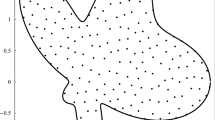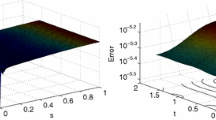Abstract
The article discusses the computer simulation system for nonlinear processes described by the Korteweg–de Vries–Burgers equation. The Korteweg–de Vries–Burgers differential equation numerically solved by the meshless approach using radial basis functions. The computer simulation system uses the following radial basis functions: Gaussian, multiquadric, inverse quadratic, inverse multiquadric, and Wu’s compactly-supported radial function. The solution of the nonlinear one-dimensional non-stationary Korteweg–de Vries–Burgers equation in the computer simulation system is visualized as a three-dimensional surface. The efficiency of the numerical solution in the computer simulation system is demonstrated by a benchmark problem for which numerical solutions were obtained, and the average relative error, average absolute error, and maximum error were calculated.
Similar content being viewed by others
References
C. H. Su and C. S. Gardner, “Korteweg–de Vries equation and generalizations. III. Derivation of the Korteweg–de Vries equation and Burgers equation,” J. Math. Phys., Vol. 10, No. 3, 536–539 (1969). https://doi.org/10.1063/1.1664873.
R. S. Jonson, “Shallow water waves on a viscous fluid — the undular bore,” Phys. Fluids, Vol. 15, No. 10, 1693–1699 (1972). https://doi.org/10.1063/1.1693764.
R. S. Jonson, “A nonlinear equation incorporating damping and dispersion,” J. Fluid Mech., Vol. 42, No. 1, 49–60 (1970). https://doi.org/10.1017/S0022112070001064.
H. Grad and P. N. Hu, “Unified shock profile in a plasma,” Phys. Fluids, Vol. 10, No. 12, 2596–2602 (1967). https://doi.org/10.1063/1.1762081.
J. M. Burgers, “Mathematical Examples Illustrating Relations Occurring in the Theory of Turbulent Fluid Motion,” in: F. T. M. Nieuwstadt and J. A. Steketee (eds.), Selected Papers of J. M. Burgers, Springer, Dordrecht (1995), pp. 281–334. https://doi.org/10.1007/978-94-011-0195-0_10.
J. Boussinesq, Essai sur la Théorie des Eaux Courantes, Imprimerie Nationale, Paris, (1877).
D. J. Kortewege and G. de Vries, “XLI. On the change of form of long waves advancing in a rectangular channel and on a new type of long stationary waves,” The London, Edinburgh, and Dublin Philosophical Magazine and J. of Science., Vol. 39, Iss. 240, 422–443 (1895). https://doi.org/10.1080/14786449508620739.
H. Demeiray, “Nonlinear waves in a thick-walled viscoelastic tube filled with an inviscid fluid,” Int. J. Eng. Sci., Vol. 36, No. 3, 345–357 (1998). https://doi.org/10.1016/S0020-7225(97)00056-6.
N. Antar and H. Demiray, “Nonlinear waves in an inviscid fluid contained in a prestressed viscoelastic thin tube,” Z. Angew. Math. Phys., Vol. 48, 325–340 (1997). https://doi.org/10.1007/s000330050034.
S. I. Zaki, “A quintic B-spline finite elements scheme for the KdVB equation,” Comput. Meth. Appl. Mech. Eng., Vol. 188, Iss. 1–3, 121–134 (2000). https://doi.org/10.1016/S0045-7825(99)00142-5.
T. S. Aly El-Danaf, “Septic B-spline method of the Kortewege–de Varies–Burger’s equation,” Commun. Nonlinear Sci. Numer. Simul., Vol. 13, Iss. 3, 554–566 (2008). https://doi.org/10.1016/j.cnsns.2006.05.010.
D. Kaya, “An application of the decomposition method for the KdVB equation,” Appl. Math. Comput., Vol. 152, Iss. 1, 279–288 (2004). https://doi.org/10.1016/S0096-3003(03)00566-6.
A. A. Soliman, “A numerical simulation and explicit solutions of KdV–Burgers’ and Lax’s seventh-order KdV equations,” Chaos, Solitons & Fractals, Vol. 29, Iss. 2, 294–302 (2006). https://doi.org/10.1016/j.chaos.2005.08.054.
V. M. Kolodyazhny and D. O. Lisin, “Meshless method to solve nonstationary heat conduction problems using atomic radial basis functions,” Cybern. Syst. Analysis, Vol. 49, No. 3, 434–440 (2013). https://doi.org/10.1007/s10559-013-9526-z.
D. O. Protektor, D. A. Lisin, O. Yu. Lisina, “Numerical analysis of solutions of two-dimensional heat conduction problems by meshless approach using fundamental and general solutions,” Applied Questions of Mathematical Modelling, Vol. 2, No. 1, 98–111 (2019). 10.32782/2618-0340-2019-3-8.
I. V. Garyachevskaya and D. O. Protektor, “Computer modeling system for the numerical solution of the one-dimensional non-stationary Burgers’ equation,” Bulletin of V. N. Karazin Kharkiv National University, Ser. Mathematical Modeling, Information Technology, Automated Control Systems, Vol. 43, 11–19 (2019). https://doi.org/10.26565/2304-6201-2019-43-02.
H. Xie, J. Zhou, Z. Jiang, and X. Guo, “Approximations for Burgers’ equations with C-N scheme and RBF collocation methods,” J. Nonlinear Sci. Appl., Vol. 9, Iss. 6, 3727–3734 (2016). https://doi.org/10.22436/jnsa.009.06.23.
E. J. Kansa, “Multiquadrics — A scattered data approximation scheme with applications to computational fluid-dynamics — I. Surface approximations and partial derivative estimates,” Comput. Math. Appl., Vol. 19, No. 8–9, 127–145 (1990). https://doi.org/10.1016/0898-1221(90)90270-T.
Y. C. Hon and X. Z. Mao, “An efficient numerical scheme for Burgers’ equation,” Appl. Math. Comput., Vol. 95, Iss. 1, 37–50 (1998). https://doi.org/10.1016/S0096-3003(97)10060-1.
Z. Wu, “Compactly supported positive definite radial functions,” Adv. Comput. Math., Vol. 4, 283–292 (1995). https://doi.org/10.1007/BF03177517.
C. Montoya, “Inverse source problems for the Korteweg–de Vries–Burgers equation with mixed boundary conditions,” J. Inverse Ill-Posed Probl., Vol. 27, No. 6, 777–794 (2019). https://doi.org/10.1515/jiip-2018-0108.
H. P. Langtangen and S. Linge, Finite Difference Computing with PDEs, Springer, Cham (2017). https://doi.org/10.1007/978-3-319-55456-3.
I. V. Sergienko, A. N. Khimich, and M. F. Yakovlev, “Methods for obtaining reliable solutions to systems of linear algebraic equations,” Cybern. Syst. Analysis, Vol. 47, No. 1, 62–73 (2011). https://doi.org/10.1007/s10559-011-9290-x.
Author information
Authors and Affiliations
Corresponding author
Additional information
Translated from Kibernetyka ta Systemnyi Analiz, No. 6, November–December, 2021, pp. 172–182.
Rights and permissions
About this article
Cite this article
Hariachevska, I.V., Protektor, D.O. Computer Simulation System for Nonlinear Processes Described By the Korteweg–de Vries–Burgers Equation. Cybern Syst Anal 57, 998–1007 (2021). https://doi.org/10.1007/s10559-021-00425-y
Received:
Published:
Issue Date:
DOI: https://doi.org/10.1007/s10559-021-00425-y




